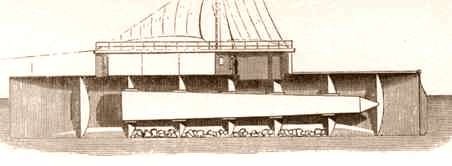
Drawing from the Illustrated London News
| Home | Parent Page |
|
Cleopatra's Needle |
First erected in Egypt, by Pharaoh Thotmes 111 around 1500BC. It was a gift to the British
people, in 1819 in recognition of Nelson's Victory over the French fleet, at the Battle of
the Nile in 1798. Opposite the Victoria Embankment Gardens, on the river front,
Cleopatra's Needle is flanked by magnificent bronze lions. The 68 1/2 ft. monolith sits on
a pedestal. The pedestal encloses various momentous objects including:
standard foot and pound, a full set of British Empire coins, Bibles in various languages,
a railway guide, an almanac, and copies of contemporary newspapers. At a
dinner held at the home of Edward A. Goodall, several artists were invited including John
Dixon the engineer. Conversation eventually centered on Cleopatra's Needle in Egypt
and John Dixon suggested that it be brought to England by private means since the
government had estimated that the cost would be too great. He said that if he had
the money he would do it himself. Shortly thereafter, Sir Erasmus Wilson the
celebrated surgeon and Freemason, called on John Dixon and offered the money to
bring the obelisk over.
|
The following is taken from the Illustrated London News March 10,
1877 |
|
There are three plaques attached to
the pedestal that holds the needle. They read: THIS OBELISK PROSTRATE FOR CENTURIES ON THE SANDS OF ALEXANDRIA WAS PRESENTED TO THE BRITISH NATION A.D. 1819 BY MAHOMMED ALI VICEROY OF EGYPT A WORTHY MEMORIAL OF OUR DISTINGUISHED COUNTRYMEN NELSON AND ABERCROMBY THROUGH THE PATRIOTIC ZEAL OF ERASMUS WILSON F.R.S. THIS OBELISK WAS BROUGHT FROM ALEXANDRIA ENCASED IN AN IRON CYLINDER IT WAS ABANDONED DURING A STORM IN THE BAY OF BISCAY RECOVERED AND ERECTED ON THIS SPOT BY JOHN DIXON C.E. IN THE 42ND YEAR OF THE REIGN OF QUEEN VICTORIA 1878. |
 Drawing from the Illustrated London News |